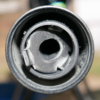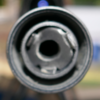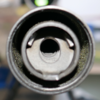The second suppressor I tested was another ASE Utra Dual Rimfire, this time designated number 1. I have 3 of these cans and this was the first one I purchased, a few years ago. I tried to position the baffles for a 9 o' clock orientation but I think it is somewhere between 8 and 9 o' clock:

Here's the TDS target:

I took the baffles out and cleaned them as before, and the inner tube and replaced the baffles. I was aiming for 3 o' clock but they ended up more like 2 o' clock:

Here's the TDS group:

Then, just for giggles, I put a special adapter on the rifle, which is a UNEF to UNEF adapter (same to same). It is a handy thing to have, for a test like this. I did not rezero the rifle, I got a group with no suppressor, just the adapter was attached. Here is the original control group on the left, and the group with the adapter installed, on the right:

So, the group moves right without even attaching a suppressor. The mere presence of an adapter put quite a change of POI on the rifle.
Then, also for giggles, I attached the same suppressor (ASE Utra Dual Rimfire number 1) to the gun. Here's the adapter and suppressor:

The baffles sat at 6 o'clock, whereas they had sat at 2 o' clock without the adapter (because I didn't take them out this time).

Here's the TDS group:


Here's the TDS target:

I took the baffles out and cleaned them as before, and the inner tube and replaced the baffles. I was aiming for 3 o' clock but they ended up more like 2 o' clock:

Here's the TDS group:

Then, just for giggles, I put a special adapter on the rifle, which is a UNEF to UNEF adapter (same to same). It is a handy thing to have, for a test like this. I did not rezero the rifle, I got a group with no suppressor, just the adapter was attached. Here is the original control group on the left, and the group with the adapter installed, on the right:

So, the group moves right without even attaching a suppressor. The mere presence of an adapter put quite a change of POI on the rifle.
Then, also for giggles, I attached the same suppressor (ASE Utra Dual Rimfire number 1) to the gun. Here's the adapter and suppressor:
The baffles sat at 6 o'clock, whereas they had sat at 2 o' clock without the adapter (because I didn't take them out this time).

Here's the TDS group:

Last edited:












